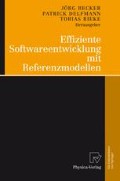Abstract
Eine Reihe von Grundsatzentscheidungen beeinflusst die Konstruktion eines konfigurativen Referenzmodellierungswerkzeugs. Hierzu zählen neben der Selektion eines adäquaten Fachkonzepts insbesondere die Auswahl der Implementierungsplattform und die damit einhergehende Softwarearchitektur des Werkzeugs. In diesem Rahmen ist auch zu entscheiden, ob die Konstruktion des Werkzeugs im Rahmen einer Neuentwicklung oder auf Grundlage bestehender Werkzeuge realisiert wird, die entsprechend erweitert werden. Der vorliegende Beitrag erläutert die Anforderungen, die ausgehend von der konfigurativen Referenzmodellierung an ein Modellierungswerkzeug zu stellen sind und leitet daraus Gestaltungsaspekte hinsichtlich der Werkzeugarchitektur ab, welche detailliert beschrieben werden.
Access this chapter
Tax calculation will be finalised at checkout
Purchases are for personal use only
Preview
Unable to display preview. Download preview PDF.
Literaturverzeichnis
The Apache Software Foundation: Xalan-Java Version 2.7.0. http://xml.apache.org/xalan-j. 2005.
Delfmann, P.; Knackstedt, R.: Konfiguration von Informationsmodellen. Untersuchungen zu Bedarf und Werkzeugunterstützung. In: Oberweis, A.; Weinhardt, C.; Gimpel, H.; Koschmider, A.; Pankratius, V.; Schnizler, B. (Hrsg.): eOrganisation: Service-, Prozess-, Market-Engineering. Proceedings der 8. Internationalen Tagung Wirtschaftsinformatik. Band 2. Karlsruhe 2007, S. 127–144.
Elliott, J.: Hibernate: a developer’s notebook. Cambridge 2004.
Sun Microsystems: Creating a GUI with JFC/Swing. http://java.sun.com/docs/books/tutorial/uiswing. 2006.
Sun Microsystems: The AWT in 1.0 and 1.1. http://java.sun.com/products/jdk/awt. 2006.
Sun Microsystems: Java Architecture for XML Binding (JAXB). http://java.sun.com/webservices/jaxb. 2006.
Sun Microsystems: Java SE — Java Database Connectivity (JDBC). https://java.sun.com/javase/technologies/database/index.jsp. 2006.
MySQL AB: My SQL — Die populärste Open-Source-Datenbank der Welt. http://www.mysql.de. 2006.
World Wide Web Consortium: Extensible Markup Language (XML). http://www.w3.org/XML. 2006.
Author information
Authors and Affiliations
Editor information
Editors and Affiliations
Rights and permissions
Copyright information
© 2007 Physica-Verlag Heidelberg
About this chapter
Cite this chapter
Rieke, T., Stein, A. (2007). Architektur eines konfigurativen Referenzmodellierungswerkzeugs — adapt(x). In: Becker, J., Delfmann, P., Rieke, T. (eds) Effiziente Softwareentwicklung mit Referenzmodellen. Physica-Verlag HD. https://doi.org/10.1007/978-3-7908-1994-6_3
Download citation
DOI: https://doi.org/10.1007/978-3-7908-1994-6_3
Publisher Name: Physica-Verlag HD
Print ISBN: 978-3-7908-1993-9
Online ISBN: 978-3-7908-1994-6
eBook Packages: Business and Economics (German Language)

